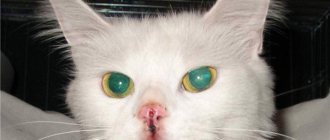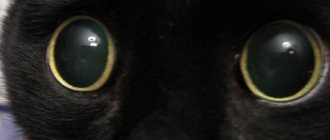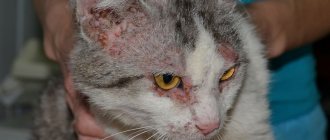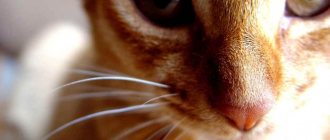If the owner notices sores in a cat or kitten in different parts of the body - behind the ears, on the neck, on the back, near the tail or on the limbs, it is necessary to determine their nature as soon as possible, because some wounds are a symptom of a dangerous disease. It is unacceptable to start self-medication without a veterinarian, otherwise serious complications cannot be avoided.
Sores in cats on the head: Diagnosis of the cause
Diagnosis is carried out in a veterinary hospital.
In Moscow, you can contact the veterinary clinics of the network “Your Doctor” or “Bely Klyk”, as well as the Innovative Veterinary Center of the Moscow Veterinary Academy (IVC MBA).
In St. Petersburg, competent specialists will help you at the clinics “Dog and Cat”, “Lucky”, “Your Doctor”.
In Voronezh, we recommend visiting the blades “Eurovet” and “Cat Matroskin”.
To determine the cause, the veterinarian will take the following measures:
- Examination of the animal with thermometry.
- Anamnesis collection (seasonal or not, new carpet at home, flowers, new animal, vaccinations, food, contact with stray animals)
- Detection of antibody titers during an allergic reaction in the laboratory, less pronounced with food allergies (immunoglobulins G. M), more pronounced with allergies to house dust or pollen (immunoglobulins E)
- General blood and urine analysis.
- Blood chemistry.
- Scraping of the epidermis from the affected areas followed by microscopy.
- Sowing material from the lesion (detection of bacteriological contamination).
- Examination of the animal's hair and skin in the rays of a Wood's lamp (spores and mycelium of microsocopic mushrooms glow with a gentle blue light).
- Microscopy of a hair taken from the periphery of the lesion.
- Cultivation of the fungus on nutrient media in a laboratory (material is taken from the center of the lesion and then transferred to nutrient media).
- Microscopy of deep skin scraping (for diagnosis of ectoparasites).
- Analysis of feces for helminthiasis.
Treatment of feline dermatitis and, in turn, treatment of scabs in cats
Diagnosis of miliary dermatitis is quite simple for a practicing veterinarian. Locating rashes, lesions, or scabs on cats—depending on how advanced the problem is—gives the veterinarian a clearer idea of the true source of the allergic reaction and a good start to a reliable treatment method. Determining the exact source of your cat's skin allergies is key.
For cats who already have ulcers from over-grooming where flea bites are to blame, knowing they have a flea allergy is not a judgment on you as a cat owner or your cleanliness at home. Cortisone injections may help relieve persistent itching and, if necessary, antibiotics prescribed to treat existing wounds.
Your veterinarian can advise preventive measures if you are aware of cat allergies. Indoor cats that like to go outside under supervision may be warned against doing so, or regular use of flea control products may be recommended. Implementing preventative strategies may require you and your cat to change your normal routine, but staying consistent with the new routine will ensure that your cat does not suffer from repeated bouts of miliary dermatitis.
A cat scratches sores on its head: If the cause is an allergic reaction
An allergic reaction is the most common cause of itchy sores on a cat's head. The animal scratches them until they bleed, scabs form, and a secondary infection may develop - then the disease is complicated by bacterial contamination.
The fur may come out in the affected areas, but may not be damaged, only sticking together with a pathological secretion.
Watch the video: Veterinarian advice - Skin diseases in cats and their diagnosis
Types, causes of appearance and characteristic symptoms
Demodicosis
A dangerous parasitic disease caused by the Demodex mite. An insect can always live on an animal’s body, but when the immune system is strong, it suppresses the life activity of the pathogen. At the slightest decrease in the body's defenses, the tick is activated. On the face, or more precisely around the eyes and on the eyebrows, red, flaky, dry spots appear, which eventually become crusty. Sometimes the pet cannot see normally with the eyes because the eyelids stick together due to mucus secreted by the inflamed mucous membrane.
Typical symptoms of demodicosis in cats are:
- Redness of the mucous membranes and severe itching sensations.
- The eyelids, eyebrows, and chin are covered with scabs.
- The animal constantly scratches the affected areas, as a result of which scratches form on the skin.
If it lasts for a long time, a bacterial infection develops; the weeping spot festers and hurts a lot.
Ear mite
Infection with ear mites leads to inflammation and irritation in the shell.
Ulcers on the ears and inside the auricle can be a consequence of the activation of the Otodectes mite, which parasitizes the cat’s hearing organs. Often the disease occurs as a result of insufficient hygiene. In the initial stages of development, the animal suffers from severe itching. Sores with an odor in a cat’s ears indicate the onset of an inflammatory process. Redness and irritation appear in the inner part of the ear. Weeping and festering scabs can provoke inflammation of the outer and then middle ear. If the pathology is not treated, the inflammatory process spreads to the parotid space, and the animal may die due to complications that develop.
Ringworm
The cause of this disease is a fungal infection. If a cat has a strong immune system, it can cope with fungi and prevent them from multiplying. However, in an animal with reduced protective functions, the pathogen develops almost unhindered. First, skin sores appear in one area - on the forehead, neck or withers, on the cheeks, stomach, limbs or along the back. In places where the parasite has invaded, the skin becomes inflamed, spots appear on this site, which are covered with dirty gray crusts. At a progressive stage, hair loss is observed. If the disease is not treated, the sores spread throughout the body.
Acne
Acne is a form of open and closed acne plaques that often form under the hair on the chin. The main reason for their occurrence is improper hygienic care of the cat, chronic inflammatory processes in the body, dysfunction of the sebaceous glands, and stress. First, the owner notices how the skin on the face is covered with black or white dots, around which the fur is thinning. Soon a hard crust forms on the acne. If treatment is not started promptly, the risk of a bacterial infection and the spread of inflammation to healthy areas of the skin increases.
Skin parasites
Flea bites often cause allergic reactions and severe itching.
Often, cat sores are the result of parasitic infestations. Common parasites that live on the skin of cats are fleas and lice. Even a pet can develop this disease, so it is important for the owner to treat the pet’s fur with insecticides in a timely manner. Characteristic signs of the disease:
- rash at the bite sites and severe itching, due to which the cat scratches its head, neck, and back until it bleeds;
- hair loss;
- redness of the affected areas;
- irritability and restlessness of the animal;
- inflammation of wounds.
Skin eczema
An inflammatory disease that affects the superficial layer of the dermis. The reasons for its occurrence:
- improper skin care;
- failure to comply with hygiene rules;
- the presence of skin parasites;
- allergy;
- liver pathologies;
- diseases of the digestive system.
The formation of wounds on a cat’s body brings discomfort to her, which is why the pet refuses to eat and loses weight.
In the initial stages of development, it becomes noticeable that certain areas of the skin are covered with spots that constantly get wet and itch. Soon, cats' scratches become inflamed due to infection. The location of the inflammatory process becomes red, the body temperature rises, fever worries, and due to constant discomfort, the cat refuses to eat and quickly loses weight.
Allergic reaction
An allergy is a violent reaction of the immune system to the introduction of a foreign protein into the body. When exposed to an allergen, dry and itchy inflamed areas form on the skin. The animal scratches these areas, causing sores to form there. If you do not give your pet antihistamines, the risk of complications, such as mucosal swelling and breathing problems, increases.
Bacterial infections
Infectious inflammation can occur in 2 forms: dry and wet. When dry, it seems that the skin is overgrown with dense crusts. Wet is characterized by hyperemia, the formation of moist, inflamed areas on which a rash and ulcers appear. The causes of this disease may be:
- allergy;
- stress;
- metabolic disorders;
- renal dysfunction;
- tumors.
Other reasons
Damage to the skin and the formation of ulcers occurs due to the development of atopic dermatitis.
Scabs and sores on a cat’s head can occur due to the development of diseases such as:
- psychogenic alopecia;
- Cushing's syndrome;
- sarcoptic mange;
- notoedrosis;
- atopic dermatitis.
A cat has a sore on its head: Treatment of an allergic reaction
- Rinse the inflamed areas with hydrogen peroxide (2-3% solution).
- Local lotions against itching, against secondary skin infections - antibiotics and/or antifungal drugs (Levomekol, Fungin).
- To eliminate itching, stop itching, antihistamines (Suprastin, Tavegil), in severe cases, single or triple use of Prednisolone subcutaneously is possible.
- Hyposensitization: after successful determination of antibodies in the laboratory, injections of serum at weekly intervals for 10 - 12 weeks (this type of treatment is practiced only in some Moscow clinics).
- Eliminating the allergen (changing food to hypoallergenic, removing carpets, flowers, isolating new animals, etc. - depends on which allergen is identified.
- Also, herbal medicine has proven itself to be effective in eliminating itching and relieving inflammation: compresses, baths, washing, wrapping with tinctures or 10-20-5 solutions of calendula, chamomile, echinacea or St. John's wort. Baths with walnut tree leaves. Washing with infusions of horsetail or pansies, decoctions of walnut leaves.
A cat has scabs on its head: If the cause is ectoparasites
The appearance of itchy sores on the head and neck, which animals scratch until they scab, may be caused by infection of the animal with ticks of the species Notoedres cati, Sarcoptes spp. All age groups and all breeds are affected.
It often starts from the outside of the ear and spreads to the head area, later to the body and tail. Severe itching, followed by the appearance of individual pustules, bran-like scales and profuse hair loss.
Like what you're reading? Check out other articles about cat health: Alarm Clock Cat. How to wean your pet from the habit of waking up? – Do cats need to be washed and if so, how? Tips for bathing tailed cats - https://strazhchistoty.ru/cleanup/cleancats/nado-li-myt-koshek.html How to learn to understand your cat? – https://strazhchistoty.ru/cleanup/cleancats/kak-ponimat-koshku.html
Muscular system
Cats have an unusually developed muscular system. This is proven by their amazing jumps over fairly long distances and fast running. Also, a set of muscles helps the cat maintain its aristocratic bearing.
Thanks to its developed muscular system, a cat is able to perform amazing movements.
In total, a cat has about 500 muscles. They can be divided into 3 categories:
- heart muscle;
- smooth muscles, which control internal organs and work involuntarily;
- striated muscles that the cat controls itself.
Special fibers are part of all muscles. Cat muscles contain 3 types of cells:
- are strongly contracted, but work for a short time - thanks to them, the cat is able to jump long distances; the strength of these cells is not able to act for long;
- with a strong contraction they work for a long time - a cat has few such cells, which explains its inability to run long distances;
- they contract quietly and work for a long time - this type of muscle cells is used in a cat when hunting, when it sits in ambush for a long time, and also sneaks quietly and gently.
When hunting, a cat uses muscle cells that can work for a long time
The structure of the shoulder girdle has a peculiarity: the muscles connect the forelimbs and the torso, while in humans they are connected by the collarbone. In cats it is in its infancy.
To take a step, the cat pushes off with its hind paws, and the front paws participate in the braking process. Thanks to the elasticity of the back muscles, the cat can easily curl into a ball and assume other bizarre poses.
Sores on a cat's head: Treatment of tick-borne infestation
- General measures: soak the peels with vegetable oils or liquid paraffin and remove. Disinfect toys, brushes, bowls and other things, wipe the surface with hot water, treat the bed with antiparasitic agents (Bolfo-plus spray, Frontline spray).
- Wash with acaricidal agents (shampoos) 1-2 times a week for 2-4 weeks.
- Treat the affected areas with Aversectin ointment 2 times a day until cured.
- Ivermectin injections subcutaneously for a week.
- To support fur restoration - food supplements with essential amino acids and vitamins (Beafar, AgroVetZashchita ).
- Washing or bathing with infusions of thyme, yarrow, cloves, lavender, ivy, horsetail, pansies, bath with walnut leaves and whey.
- Baths with sulfur-containing preparations or shampoos with tea tree oil 1-2 times a week until improvement.
The cat has sores on its head and hair has come out: If the cause is fungal infections
Mainly kittens, old and weakened animals are susceptible to infection with fungal diseases (the latter include cats after suffering severe infectious diseases, receiving drugs that suppress the immune system, and having a meager feeding ration).
The causative agents are microscopic fungi of the species Microsporum Canis, Microsporum gypseum or the genus Trichophyton. Healthy animals, due to their strong immune system, can be asymptomatic carriers of pathogenic fungal spores for a long time.
Infection occurs when fungal spores come into contact with the fur or skin of an animal from environmental objects or through direct contact with a sick animal. The incubation period (the time from the moment of infection to the appearance of the first signs of the disease) ranges from 1 week to 1 month.
Clinically, fungal infections in cats are practically the same. Most often the head, ears, neck and back of the animal are affected, less often the limbs and abdomen.
The disease begins with hair loss in a limited area, the cat scratches the affected area, the skin is covered with scales and crusts, the lesions tend to merge and grow.
With extensive damage, the general condition of the animal may also suffer: appetite worsens, lethargy or, conversely, aggressiveness appears.
The best foods for cats with allergies
Main features
Pimples can be single or multiple; they look like a small bump above the skin. Sometimes they are quite difficult to see under the fur. The skin at the site where the pimple appears is hyperemic.
Acne most often appears on a cat's lips and chin. These are multiple black rashes (acne). Sometimes they are confused with waste products of endoparasites or dirt. Over time, pathogenic microflora joins the process, the skin on the chin becomes red and itchy. The animal begins to scratch its chin, causing wounds to itself.
The cat has sores on the neck, on the head: Treatment of fungal infections
- Local treatment in the form of ointments. (Yam, Sanoderm).
- Local treatment using Fungin spray.
- Use of the therapeutic vaccine Vakderm, Polivac.
- Bathing with antifungal shampoos once every 3 days for 6 weeks.
- For generalized lesions, antifungal drugs are used orally ( Introconazole , Terbafine).
- Complete balanced feeding.
- Use of vitamin and mineral supplements to feed.
- Avoid scratching and licking (wear a collar).
- In long-haired animals, it is advisable to clip the affected areas.
- Washing with vinegar water and horsetail infusion.
Precautions for fungal infections in domestic cats
The disease is anthropozoonotic – that is, transmitted from animals to humans and vice versa. Children and the elderly, as well as those weakened by other diseases, are most susceptible to infection with the fungus.
Therefore, if there are children, old people or seriously ill people in your house, then of course the most optimal solution would be to isolate the sick animal in another room until it has fully recovered.
If the inhabitants of your apartment are all adults and healthy people, then it will be enough to treat the cat’s skin with ointments, wearing gloves and a mask, carry out daily wet cleaning using antiseptics, iron the fabrics with a hot iron, and wash your hands.
A cat has a bump on its head: Possible causes
If you find a lump on your pet's head, the reasons may be the following:
- Lipoma formation.
- Abscess formation.
- Metastases of a malignant tumor of any organ.
Lipomas are formed from cells of subcutaneous fatty tissue and are benign formations; with trauma they can degenerate into malignant ones. The reliable reason for their formation, however, like all neoplasms, is unknown.
Abscesses can form at the site of an injury, a bite during a fight with other animals when the immune system is weakened and the wound is contaminated, when the animal has access to the street, or its habitat in the apartment is polluted. The cat's scratching and licking of the wound plays an important role.
Since the formation can be a signal of a serious pathology, it is necessary to immediately contact a veterinary clinic.
After the diagnosis, which will necessarily include a tissue biopsy or puncture followed by histological examination, the veterinarian will select the necessary treatment tactics.
Watch the video: Ear mites - How to cure a cat at home
Internal structure of a domestic cat
Representatives of the cat family are mammals, so the structure of the internal organs of a cat is practically no different from similar structures of other creatures included in this class. The systems and organs of these animals work according to principles characteristic of most mammals and perform similar functions. However, there are features that are unique to cats. The internal structure of a cat can be seen in the photo, and a description of the most important systems is presented below.
Internal organs of a cat
The cardiovascular system
The cardiovascular system is formed by a network of blood vessels and the heart, which ensures the movement of blood cells and lymph. The main function of this system is to saturate tissues with nutrients and oxygen, as well as remove waste products.
The heart is a special muscle in a cat's body. It has 4 chambers: 2 atria and 2 ventricles. In an adult cat, the weight of the heart is about 15–30 g. The ventricles of the heart contract and force the blood to move through the vessels.
Large blood vessels - veins and arteries - carry blood away from the heart and return it back. Small vessels are capillaries that deliver blood to the organs. Thanks to them, tissues are saturated with oxygen and nutrients. Blood consists of blood cells (red blood cells, platelets and white blood cells) and plasma.
Digestive organs
The digestive system includes the oral cavity (tongue, teeth, salivary glands), pharynx, esophagus, stomach and pancreas, liver, gall bladder and intestines, which includes 4 sections: duodenum, small intestine, ileum and large intestine. The esophagus starts from the base of the mouth and connects to the stomach, the inner surface of which is formed by many folds. They increase the mechanical effect on food masses during digestion.
The food then passes through the pyloric sphincter and enters the duodenum. Here the food is mixed with pancreatic and liver enzymes. The digestion process continues.
In the small intestine, all nutrients are absorbed thanks to the many villi lining the inner surface of the intestine. The mass then turns into feces, passing through the ileum and colon, where excess moisture is sucked out of it.
Central and peripheral nervous system
The nervous system of cats consists of central and peripheral parts. The central nervous system includes the brain, spinal cord and brain stem. This part is responsible for reflex actions, behavior and reactions to external stimuli.
Anatomy of a cat's nervous system
The peripheral section ensures the regulation of conscious movements. The ability of cats to move, groom themselves, hide and extend their claws, and perform all conscious actions depends on the operation of this system.
The central and peripheral sections are interconnected. Impulses from parts of the body enter the brain, which sends response signals.
Respiratory system
The respiratory system is designed for gas exchange processes. The respiratory organs saturate the body with oxygen and remove carbon dioxide. Normally, cats breathe quite frequently. In 60 seconds, a cat can take up to 100 breaths. The respiratory system includes:
The main respiratory organ is the lungs. The lung located on the left has an additional lobe, so its size is slightly larger. Through the alveoli, oxygen enters the bloodstream, and carbon dioxide exits.
Reproductive organs
The genitals perform a reproductive function. Kittens reach sexual maturity and readiness for breeding at 8–11 months. During this period, their behavior changes, cats begin to look for a partner for mating. The females have their first heat. The reproductive organs of a cat include the ovaries, bicornuate uterus, fallopian tubes, cervix, vulva and vagina. The ovaries ensure that the female’s body is ready for pregnancy and bearing offspring. Fertilized eggs mature in the horns of the uterus.
The male reproductive system includes the prostate, testes, scrotum, vas deferens and penis. Sperm mature in the testes and testosterone is produced. The seminal fluid comes out through the ducts.
Endocrine system
The function of the endocrine system is to produce hormones and maintain their normal levels in the blood. Hormones regulate many processes occurring in the body. Most hormones are produced by the hypothalamus and pituitary gland, which are located in the brain. In this part of the endocrine system, cortisol, antidiuretic, follicle-stimulating, adrenocorticotropic hormone, oxytocin, and corticoliberin are released.
Hormones are also produced in the adrenal glands, thyroid gland and ovaries. The adrenal glands produce cortisol, which is formed in the cortex of this organ. Cortisol takes part in the regulation of metabolic processes. The adrenal medulla also produces important hormones - adrenaline and norepinephrine. These substances influence the pulse rate and regulate the constriction of blood vessels.
Sex hormones - estrogen and progesterone - are produced in the ovaries. They are responsible for the behavior of cats during the mating period, promote pregnancy in females, prepare the body for conception, and participate in the development of the egg.
Urinary system
The feline excretory system includes the kidneys, ureters, bladder and urethra. The kidneys are located behind the intestines. This is where the process of urine formation begins. The processed fluid passes through the ureters and enters the cavity of the bladder, from where it is discharged out through the urethra.
The urinary system ensures the removal of waste products from the body. The kidneys regulate water-salt balance and are responsible for the formation of hormones such as renin and erythropoietin. These substances are involved in the process of hematopoiesis and regulation of pressure in blood vessels.
A cat has a lump on its head: Treatment options
- If a cat is diagnosed with a lipoma - a benign formation of subcutaneous fatty tissue, then the doctor may decide to leave the animal under observation if the size of the formation is small and does not interfere with it, or if the cat is old or weakened by other diseases. In case of injury to the lipoma, its large size or inconvenient location, as well as in the satisfactory general condition of the pet, a veterinary specialist will perform a surgical operation to remove the tumor.
- Treatment of abscesses can be as follows: surgical opening of the abscess under general anesthesia and sedation of the animal, treatment of the affected area with antiseptic solutions (Chlorhexidine, Miramistin, Fukarcin), application of dressings with antibacterial ointments (Levomekol), administration of antibiotics intramuscularly for a course of 5-7 days (Doxycycline, Enrofloxacin ) for deep and extensive lesions, putting on a collar to prevent self-trauma, isolating the cat from other animals, complete and balanced feeding with soft and semi-liquid food or premium and extra-premium industrial food in the form of pates, vitamin therapy ( Gamavit , Hemobalance).
- If metastases are detected, the veterinarian will suggest palliative therapy or euthanasia of the animal for humane reasons.
Types of rashes
There are several types of rashes and neoplasms on the ears of cats:
- inflamed pimples (ulcers);
- abscess;
- lipoma (fat).
The formation of small pimples with purulent contents is associated with infection of wounds and cracks in the ears. Such ulcers appear if a cat scratches its ear.
An abscess is a large cavity filled with pus. It differs from acne in its larger size and amount of contents, as well as severe inflammation of the skin around the suppuration. The epidermis around the abscess often turns red and the skin temperature rises. Abscesses can open on their own, then a large wound is formed, from which pus is released. Such tumors on the ears are very dangerous, since the purulent contents can enter the general bloodstream, thereby causing infection of the entire body.
A lipoma or wen is a soft ball under the skin. A characteristic feature of a lipoma is that if you pull back the skin with the tumor, the wen easily rolls under your fingers, which does not cause any discomfort to the cat. Lipomas themselves are not dangerous, but in older animals they can begin to degenerate into cancer, so veterinarians advise removing them.
Small pinkish pimples on a cat's ear are most often the result of an allergy to food or chemicals.
Sores in cats on the head: Methods of prevention
- Avoid contact with street animals
- Complete balanced feeding
- Carrying out regular veterinary examinations and vaccinations
- Avoid contact with stray cats and dogs.
- Castration of males.
- Maintaining the hygiene of the cat’s habitat: regularly changing the tray, washing the bowl, cleaning the room.
- To maintain the animal’s immunity, use vitamin and mineral supplements from Beafar and AgroVetZashchita.
- Regular treatment of cats against ecto- and endoparasites.
Quantity











